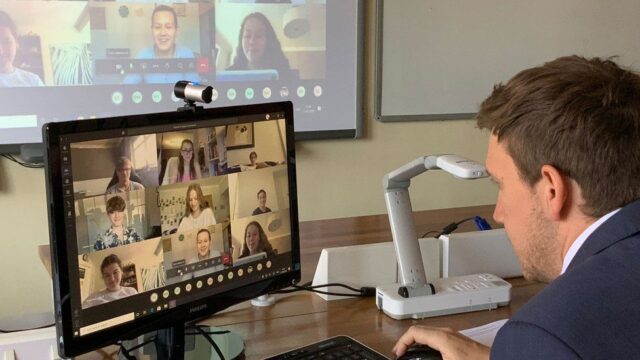Classes can be dull, boring, and old-fashioned. If you have ever hosted an online class, then you know how hard it is to attract people to attend while you’re just sitting there in front of a screen. If you’re running online classes with your students, you’ll want to make them fun and engaging.
If you’ve ever heard of the saying “Learning is a process of discovery”, then great! That’s what online learning will help you do. It’s all about finding out what works best for each individual or group and then making it effective.
Without further ado, here are some tips that will help you make your online classes more fun and creative:
1. Send Invites
The first step to making online classes fun and creative is to send invites. You want your students to know that they are part of something bigger than themselves. It’s like having a party with friends, except you’re not in the same room with them.
Sending out email invitations with each activity in your course allows your students to prepare for the sessions before they actually start.
2. Use Chats and Monitor Them
Make sure that the chat is active by checking in every few minutes during the first couple of weeks of class. You can also monitor who is chatting by hovering over their name on the left column in chat.
It’s also important to monitor the chats so you can answer any questions that come up. If you don’t respond in a timely manner, your students will feel like they were being left out or ignored.
3. Show Your Face

It’s always good practice for instructors to show their faces when they’re teaching online classes so that their students can see who they’re talking to in person. They might have any questions or need help understanding something particular about the content of their class.
Besides, showing your face helps build trust between yourself and your students and gives them peace of mind.
4. Create a Virtual Classroom Poster
You can create an online class by creating a virtual classroom poster with the materials and activities you want your students to do. You can use free tools such as Google Slides, Google Drive, or PowerPoint to create a virtual classroom poster. This will allow students to easily share their work with the rest of the class.
You can also use other online tools like Google Docs to create a virtual classroom poster that includes handouts, assignments, and gradebook information.
Make sure you use appropriate fonts and colors to make your posters appealing and unforgettable. PosterMyWall can help in creating posters by using attractive templates that will make your students look forward to the online lesson. It’ll only take you a few minutes to make an eye-catching, professional poster using PosterMyWall!
5. Ask for Feedback from Your Students
If you want your students to feel invested in the course, ask them for some input on how to improve it. Ask them what they like and don’t like about the course, whether there’s anything they’d like added or removed, etc.

You’ll be surprised at how much this type of feedback can help you make the most out of your online classes.
If you ask for feedback at the end of each assignment, then you can use that feedback as you decide on which assignments need improvement or whether or not it’s worthwhile for your students to continue on with future courses.
6. Get Creative with the Content Format
Don’t just copy another course from a popular site or try to get the same experience by using their materials. Instead, find ways to make your course unique and engaging for students.
For example, if someone has already taken the course on your topic, consider creating a new assignment that requires them to write about what they learned from it in their own words.
7. Create Online Task-oriented Groups
Your students can work together on an assignment or project as a group and then share their work with each other after completion. If there are any problems or questions, they can communicate with their classmates easily by posting comments under each individual assignment or project as per their groups.
Invite them to do research and share their findings in the groups. This will ensure everyone contributes something unique to their research.
8. Plan Interactive Activities

Interactive activities such as puzzles and quizzes are also very effective in motivating your students to learn more about your subject matter. By making the learning process more engaging, you will encourage them to stay engaged and motivated throughout the session.
9. Record Lessons
Recorded lessons come in handy when your learners are trying to grasp something unclear. They can also be used by those who were absent.
To do this, you want to record your lessons in either video or audio format. Doing so will make it easier for your students to follow along with you. If you are using a video recorder, you can record the lesson and then upload it onto an app for students to access later.
Make sure the video is high quality. Don’t worry about being “teacher-like” in your delivery. Also, use humor when possible. Don’t be afraid to mix it up and try different styles of speaking or narrating.
Be creative with how you approach the material. Use props, visual aids, or other methods to help bring your lectures to life.
10. Break Complex Topics Down to Smaller and Digestible Ones
It’s important that your students have a consistent pace of learning in an online course. If they are not able to grasp the material at a certain point, it will be difficult for them to continue with their studies.
Consider breaking down complex concepts into smaller parts and teaching them one at a time so that they can understand them better and retain what they have learned.
You want to make sure that each topic has its own section/topic, but it doesn’t have to be too long or too complicated.
11. Add Photos / Illustrations

Some people find it easier to learn with pictures or illustrations. Pictures are great because people tend to remember them better than words alone. If possible, try adding pictures or illustrations to help break up text in a class description page or lesson plan outline. This makes it easier for students to relate what is being said with visuals instead of just reading text on a page.
12. Allow Students to Create their Own Video Lessons
If you’re going to create an online course where students are expected to work together and interact with each other, consider an assignment where they create their own video lessons for the class.
This gives them a chance to practice communicating with others over video, and it allows you to see how well your students communicate with one another before you let them test out of class.
You can advise them to take advantage of the available online tools such as PosterMyWall to create engaging short videos that will increase their memory.
Final Thoughts

The most successful online classes integrate creativity. This is why mixing and matching subject matter is necessary for effective teaching. As a teacher, you can build your own creativity-focused courses by combining new skills with old ones, web courses with in-person activities, and art with writing.
Even when a subject matter is uninteresting, your creative abilities can be put to use. After all, creativity has the potential to engage students more effectively than any other skill and will play an important role in the future of online education.







